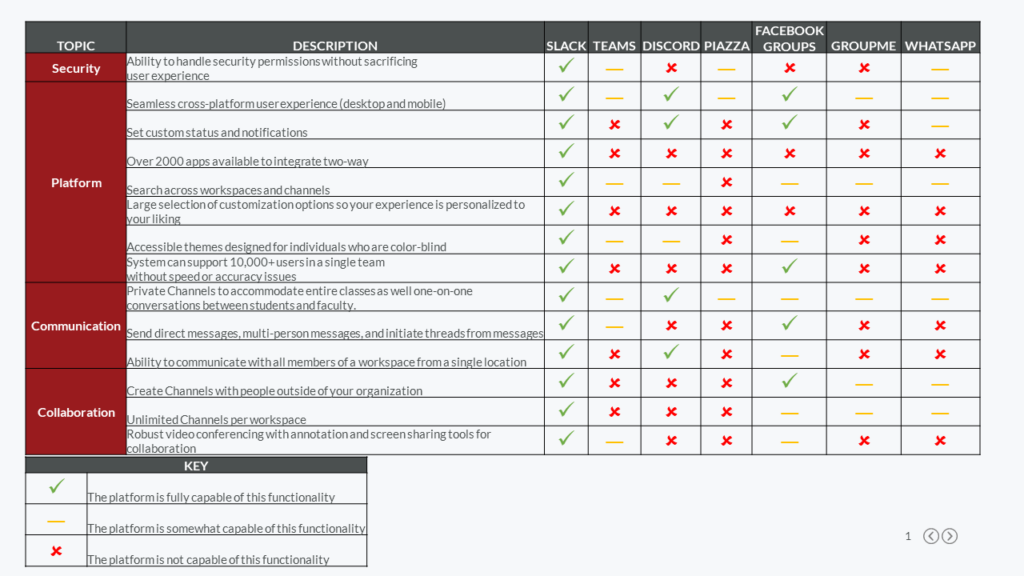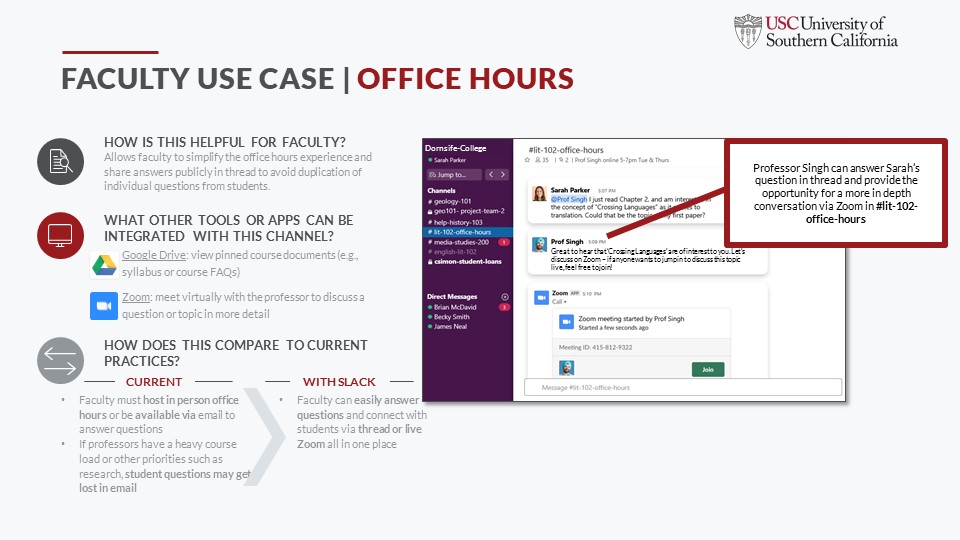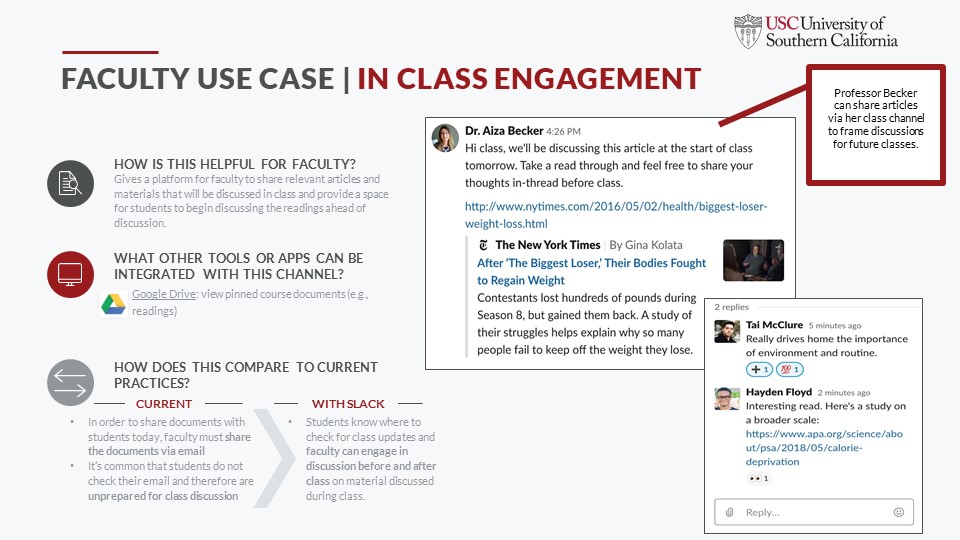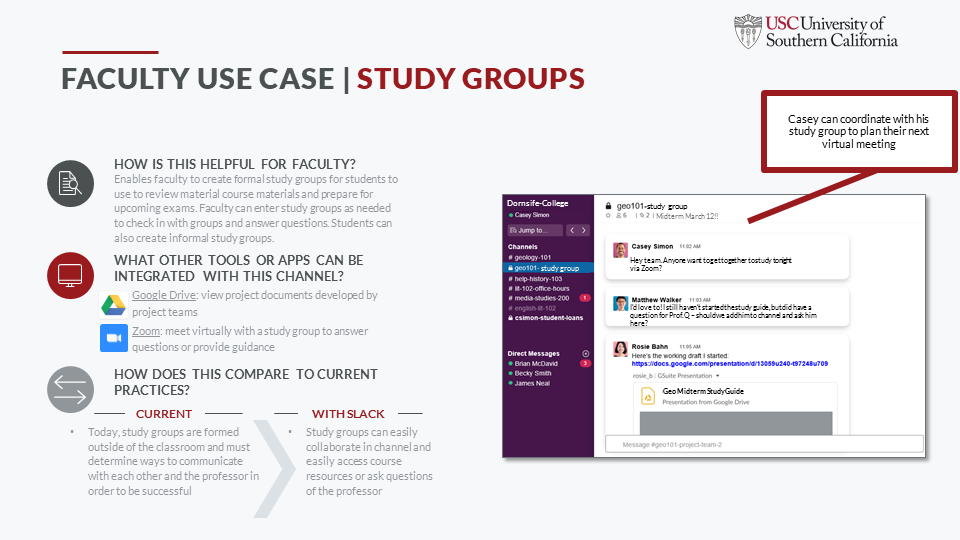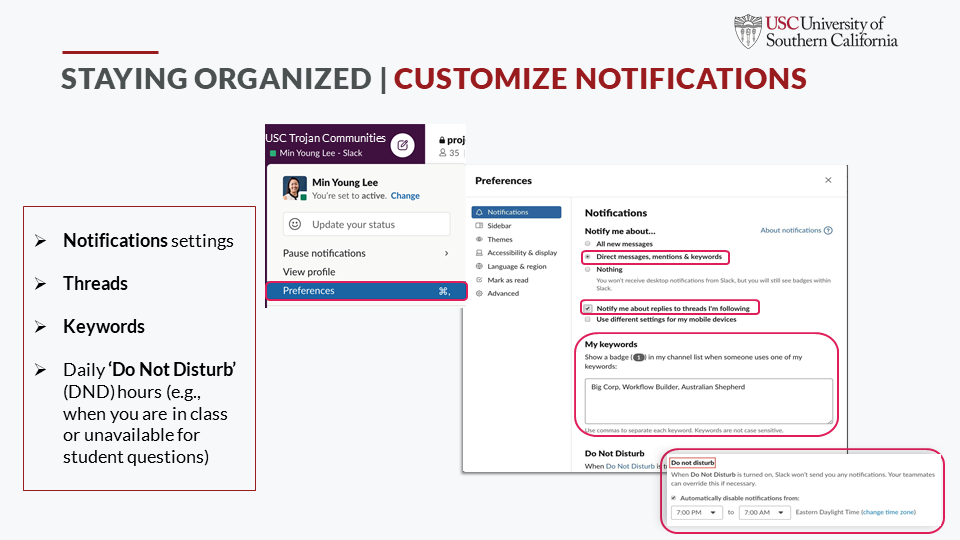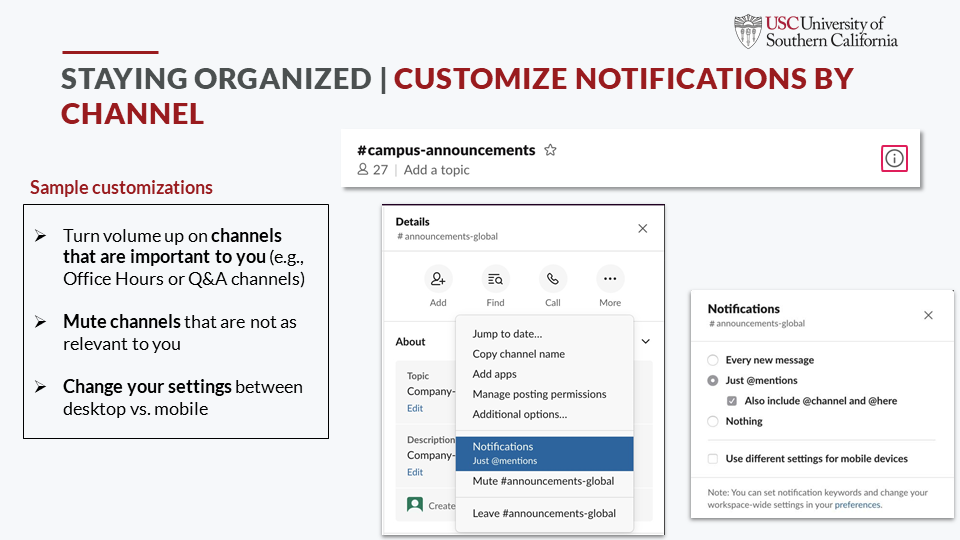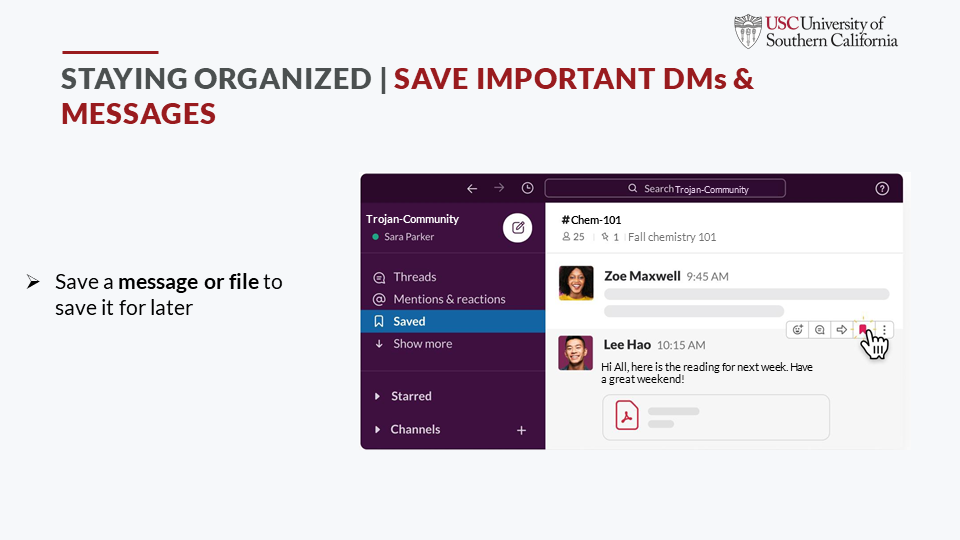Getting Started with Slack at USC
What is Slack?
Slack is a key component of USC’s Digital Campus. Slack is a central collaboration hub for students, faculty and staff. Faculty and students can easily collaborate on their courses. Ultimately, this real-time solution makes working together even simpler. Slack can be accessed anywhere and at any time to instantly connect users in a searchable platform for real-time messaging, content sharing, learning, and more.
Slack keeps everyone connected and aligned, no matter the location of your students or colleagues. First time logging into USC slack? Download the app
To learn more about using Slack at USC, watch this short video on Trojan Learn.
Short Videos on How to Use Slack
To learn more about using Slack at USC, visit Trojan Learn, and search for “Slack” to watch a few short videos about basic functionality. The following subjects are covered:
- Introduction to Slack
- Find and Start Conversations
- Working in the Right Place
- Focusing on What Matters in Slack
- Tips and Tricks
Accessing Slack for the First Time
Slack may be accessed by using the following link usc.enterprise.slack.com. All class channels will be located in the respective school workspace. These channels are created as private channels.
If You Are a New User
If you are accessing Slack for the first time, you need to download the app. When you launch Slack, you should see your class channel along the LEFT panel, including Trojan Talk as well as the classes related to your School’s workspaces.
The channel will be created with this naming scheme:
fall20+[course code]+[section]
for example:
#fall20-ot250-47703r
for Occupational Science and Occupational Therapy 250
If You Are An Existing User
If you are an existing user, you should see your class channel along the LEFT panel, including Trojan Talk as well as the classes related to your School’s workspaces.
The channel will be created with this naming scheme:
fall20+[course code]+[section]
for example:
#fall20-ot250-47703r
for Occupational Science and Occupational Therapy 250
All faculty, students and TAs will be auto provisioned into the course Slack private channels.
Downloading Slack
To optimize Slack’s features, download the app onto your desktop and/or mobile devices. The app version of Slack will allow you to receive notifications and collaborate from any device, helping you to stay in sync, no matter where you are studying.
To ensure an optimal experience, download the Slack app onto your mobile device and/or desktop at https://slack.com/download
Slack Interface Overview
Click here to learn more about the Slack Interface. Slack includes workspaces, channels, direct messages, and more to help you connect easily with your students and colleagues.
- Workspace – A workspace is a separate instance of Slack that sits under the USC Enterprise Grid. A workspace has its own administrators and permission settings, and its own members, channels, and apps to enable a large group of people to collaborate long term.
- Channels – A channel is a context-based conversation where groups of people can communicate and interact with information related to a common topic (e.g., project). These can be public or private and can be within a single workspace or shared across multiple workspaces (i.e. organization channels like #its-announcements).
- Direct Messages – Private 1:1 communication between you and anyone else on our Slack grid, regardless of workspace. You can also create group DMs with up to 8 people.
- Channel Name – Provides a first-glance insight into what conversation is contained in the channel. This should follow a shared convention for consistency purposes.
- Chat Box– Once you’re in a channel or Direct Message, you can type text into the message box and send it to the channel or Direct Message to communicate. You can also upload files or pull in attachments from your document management solution.
- Search – Enter search words to search for all the information that has been shared publicly across your Slack workspaces. This includes all public channels in the workspaces you are a member of, as well as the private channels and direct messages you participate in.
Setting Up Your Profile
Having an accurate profile will help you work more effectively with other students, staff, and faculty across the university. Your profile lets people know who you are, what you do, and how you can be contacted. You can also add a profile picture for additional personalization!
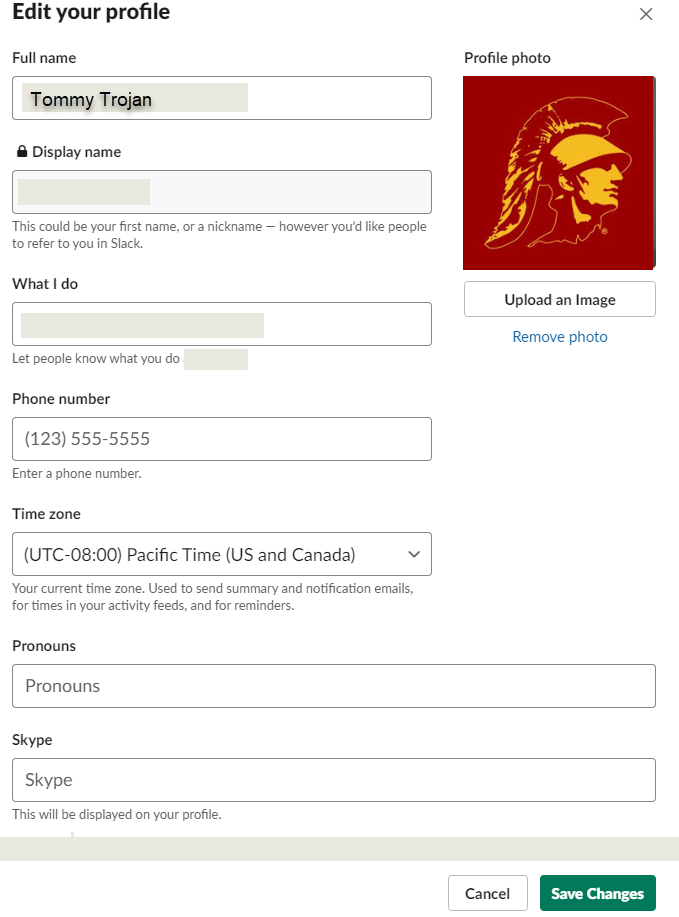
To set up your profile in Slack, complete the following steps:
- Click your workspace name in the top right of the screen
- Select “View Profile”
- Click “Edit Profile”
- Edit your profile, then click “Save Changes”
- Note: You cannot update your display name in USC Slack
Setting Do Not Disturb Hours
Establish Do Not Disturb hours for (e.g., when you are unavailable for student questions or in class) to mute desktop and mobile notifications.
- From your desktop, click your profile picture in the top right.
- Hover over Pause notifications.
- Choose a time frame from the menu, or select Custom to set your own.
- To turn off Do Not Disturb, hover over Pause notifications and select Turn off, or hover over Adjust time to choose a time frame.
Getting Support
For all questions and issues regarding using Slack at USC, please contact ITS Support.
Why Faculty Should Use Slack
Difference Between Slack & Other Platforms
Key Features
Slack should be your go-to platform for collaborating. Slack improves faculty-student engagement and interaction, which is a factor in student success. Additional features that make Slack the recommended platform for faculty to use include:
- Access: Slack is easy to access and includes a seamless user experience on any desktop & mobile device.

- Reduced Emails: Slack can significantly reduce your email clutter and lessen the time it takes to find important information. Reduce email volume by communicating in open channels & building a shared searchable archive. Direct messaging allows you to communicate directly to the person you need to contact. You can send anyone on Slack a direct message (or group DM) across the university. Even if you’re on multiple workspaces, your DMs are consolidated into a single view, making it easier to keep track of your conversation history.
- Communication: Faculty members can look up anyone (other faculty members or students or staff) who have access to the official USC Slack grid. Announcements can be shared widely or directly to the people who need to know through channels. Emojis help make communication simpler and more fun when managing workflows within your channels.

- Collaboration: Ask questions and receive updates in real time. With Slack, faculty can also share documents and set alerts for upcoming due dates and deadlines. Set reminders for yourself or other members of your workspace for important meetings, to-do items, or anything you might need to come back to later.
- Integration: Many of the tools you use now will are integrated into Slack (including Zoom and Google Drive). Slack can serve as a one-stop shop for most educational tools you will need for your instruction.
- Transparency: Transparency is a cornerstone of the Slack platform. The Channels feature allows for conversations to be open and searchable. These conversations can become an archive of important information. Understanding how to properly use this feature will allow you to build a knowledge resource that students and colleagues can refer to when they have questions.
Recommended Slack Settings
Optimize Mobile Phone Notifications
When you’re using Slack on the go, you need to optimize your notifications. To do so, swipe right and then click Settings.
From here you can do a few things:
- Toggle your availability as “Active” or “Away.”
- Under Notifications, check “Direct Messages, mentions & keywords.”
- Set “Do Not Disturb” hours indicating when you want Slack to take a daily pause from pushing notifications (e.g. 7pm to 7am).
Pin Important Announcements
Pin important class announcements to channels for students to reference at any time.
- Scroll over the message you want to pin (e.g., welcome announcement with Syllabus attached), and click on the three dots icon that appears in the upper right hand corner of your message or file content. This should say “Show message actions.”
- Select “Pin to #channel”. 2.When prompted, select “Yes, pin this file.”
- You can now click the pin icon located under your channel name to reference pinned items in that channel, any time.
Bookmark Items in Slack to Find Later
Bookmark classroom channels, syllabi or other course documents, or important messages with the ‘Save’ function.
- Hover your mouse over the message or item you would like to make note of.
- Click the save icon. This will add the item to your personal Saved items list.
- To access this list, click the Save button on the sidebar.
- To remove items from the list, click the save icon again.
Search in Slack
Search Slack for documents, threads, or topics.
- Use the top navigation bar to search through Slack.
- Type your question or topic into the search bar and press “Enter”. This will search within all public channels, private channels which you are a member of, and your DMs.
- To narrow down your search, select one of the filters on the right side of the screen. This will allow you to search messages by certain people, within certain channels, or within a date range.
How to Use Slack in the Classroom
Slack for the Classroom
Several protocol have already been put in place to enable the usage of Slack for classes each semester.
Pre-Semester
- A channel will be set up for each class in the school workspace (e.g., Viterbi School of Engineering channel) it sits under.
- Faculty will automatically be added to Slack channels for courses they are teaching.
- Faculty can then customize the channel class channel by adding documents or announcements.
- Faculty can also set up additional channels for a class to fit the needs of the course, such as for office hours, class Q&A, discussion sections, etc.
During the Semester
- Students will automatically be added to Slack channels for the classes they are signed up for.
- Faculty can set up additional channels during the semester as needed (e.g., class project groups, additional discussion sections).
Post-Semester
- The cour
- se channel will remain active for one more semester and then will be archived in Slack.
- The channel will not be deleted, so users can search for material from the channel in Slack even after the channel is archived but will not be able to actively use it.
Merging Class Channels With Channel Tools
There are two sets of steps you must complete in order to merge multiple class channels. The steps below illustrate both processes.
Process 1: Installing Channel Tools
- In your workspace, click “More”, and select “Apps”
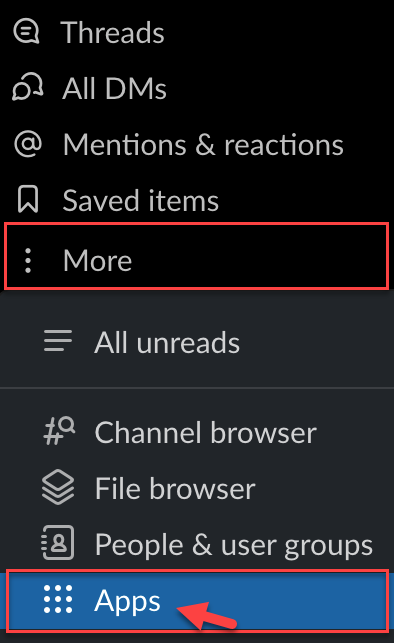
2. Search for “channel tools”

3. Click “Channel Tools” and “Click Add”. This will open your web browser to the slack app directory page for Channel Tools
4. Click “Add to Slack”
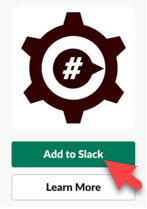
5. Click Allow
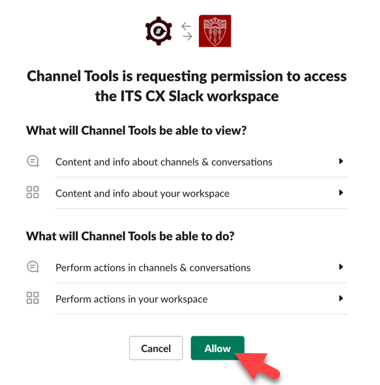
6. Click “Open Slack”
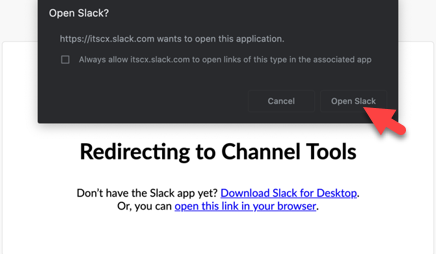
Process 2: Adding Channel Tools to your source “current” channel and your destination “new” channel
- Use @channeltools and click “Channel Tools”

2. Click “Invite Them”

3. In your destination channel, type /channeltools import and hit enter. This will bring up the Channel Tools “Select channel” option.

4. Choose your source channel and click “Yes, import all members”

5. Select More Information if you would like details on the import , or select Done

All members from your source channel should now be in your destination channel.
Setting Expectations
It is important to set expectations with your students around how you will use Slack in the classroom, as an instructor, as well as how you would like students to engage with the platform during class. Here are a few example expectations to consider:
1. Update Profiles- Be sure to remind student to update their Slack profiles to ensure both you and their peers can easily identify and communicate.
2. Response Time- Set expectations around when students can expect a response to messages, outside of your designated office hours.
3. Peer Assistance- Encourage students to help each other by answering questions in the chat from their peers, in the event that you are in the middle on instruction or are unavailable.
4. Instructor Availability- Share your availability, in the form of setting Slack office hours, or updating your status, to make students aware of when they can reach you.
5. Course Policy and Guidelines- In addition to USC’s Slack policy, be sure to set and share guidelines around how you want Slack to be used in your classroom, to ensure both you and your students are aligned.
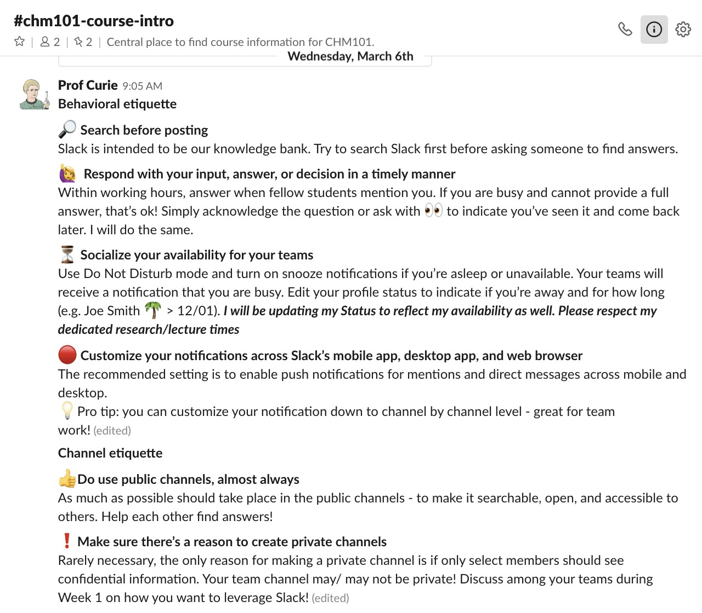
Use Slack + Zoom to host virtual lectures and office hours
Slack can be easily integrated with the Zoom application to bring classes and groups together in an instant. Consider using Slack and Zoom to host virtual lectures or office hours. Before you can get started:
- Confirm your Slack and Zoom accounts are linked to the same address
- Approve Slack in Zoom
- Install the Zoom app to Slack
- Connect Your Account

Start a Thread to organize a discussion board within a channel
Start a thread from any message to organize discussions in channels and direct messages (DMs). Threads let you discuss topics in detail without adding clutter to a conversation’s main view and help make discussions easier to keep track of.
- Clearly tie your feedback and thoughts to a specific message or file.
- Organize conversations and preserve meaningful context.
- Encourage open discussion without distracting others.
How to Use Threads
- Hover over the message you would like to respond to and click the speech bubble icon “Start a thread”.

- Type your reply and click Send.
- (a) Call attention to your response in channel by checking the “Also send to #channel” checkbox

- Your threaded reply will be connected to the original message.

Tips for Using Threads
- Unfollow a Thread to stop receiving notifications: Click “More Actions” when hovering over a message
- Follow a Thread you are not a part of to receive notifications: Click “More Actions” when hovering over a message
- View all Threads you follow by clicking “Threads” in the left sidebar.
Add and Share documents for collaboration on group assignments and tasks
Add and Share documents for collaboration on group assignments and tasks. You can choose and upload files to Slack from your device or your preferred file management app, like Google Docs. Uploaded files are stored, searchable, and shareable across your workspace.
How files work in Slack
- Drag and drop up to 10 files into the message field in Slack or click the paper clip icon next to the message field. If you clicked the paper clip icon, choose where to upload a file from.
- Add a message about the file(s) if you’d like.
- Below Share with, choose where to share the file. To share a file later, or to keep it private, uncheck the box next to Share with.
- Click Upload.
Click here to learn more about sharing and collaborating on documents with Google Drive for Slack.
Slack Workspaces
Using Slack Workspaces
A Workspace is a shared hub, where faculty, students and staff communicate and work together in channels. If you ever need to get back to your workspace, you can open up the Slack app, or visit usc.enterprise.slack.com and click on Get Started or Your Workspaces at the top of the page.

Best Practices for Workspace Management
- Set up and Manage Apps on your Workspace
- Pre-approve integrations with other software tools you’ll be using in your course.
- Visit Slack’s Help Center for more guidance on managing apps on your workspace.
- Invite Members to your Workspace by Uploading their email addresses to Slack
- Students should be added to your workspace before the term begins. Once students are invited, the workspace for your class should appear when they log into Slack.
- Visit Slack’s Help Center for more information on inviting members to your workspace.
USC-Wide Slack Workspaces
All students faculty and staff ay join the Trojan Talk workspace to discuss and collaborate on informal and social channels. Students, faculty and staff may create their own private channels, visible by invite only.
Slack Channels
Using Slack Channels
This page serves as a guide for understanding how to use Slack Channels. Slack workspaces are organized by channels, allowing people to come together on a specific topic. Depending on your settings, users may be able to create and archive channels as needed for projects they are working on. Because channels are only visible for users who have subscribed to channels, having a multitude of channels will not have any negative impact on your workspace.

Public vs. Private Channels
- Public channels: Can be browsed and joined by anyone in the workspace. Public channels are denoted with a # in Slack. Searching a workspace will return results from all public channels on your workspace (even if you’re not a member of that channel). Workspace members can join and leave public channels at will.
- Private channels: Can only be viewed and joined if you’re invited by an existing member of the channel. Private channels are denoted with a lock icon (🔒). Search will only return results from private channels of which you are a member – even if you’re an administrator. Private channels should be reserved for group projects and other topics that are not for the entire class’ eyes. Class channels that have already been provisioned will be private.
How to Create a Channel
As a faculty member, you can create additional private channels for your courses within your school’s workspace. To create a channel in Slack, complete the following steps:
- Click the plus icon next to Channels in the left sidebar.
- Enter a channel name. If you see the option to choose a channel prefix, you can select one from the drop-down menu. Channel prefixes help promote organization and consistency in Slack to help members determine where relevant work is happening. Slack offers three default channel prefixes — #help, #proj, and #team. Workspace administrators can add additional prefixes to show in this dropdown menu. Faculty can suggest additional prefixes to their workspace administrators.
- Channel names must be lowercase, without spaces or periods, and shorter than 80 characters.
- Add a description to let others know what the channel is about.
- Use the toggle to make the channel public (visible to everyone in the workspace) or private (visible only to members invited to the channel). Note: Once a channel has been created as a private channel, it cannot be converted to a public channel. (public channels can be converted to private)
- When you’re ready, click Create Channel.
Channel Naming Guidelines
Channels should reflect your class structure to allow students to find your channels easily. You should try to keep naming mechanisms as consistent as possible across schools or departments. Examples of effective channel naming include:
- #term year – course code – section. This naming convention will be used for all course channels. For example, Occupational Science and Occupational Therapy 250 channel will be named #fall20-ot250-47703r. Additional private channels created by the faculty member for a course should include this naming convention plus the purpose of the new channel.
- #topic- For general discussions of a particular topic. E.g., #topic-health-disparities
- #team- For a group of people to talk among themselves. This would be a good choice for a study group or other groups. Team channels are not for work on a particular project.
- #proj- Project channels are for a group of people to work together on a project. Projects are usually defined as having an end date or a specific goal. There might be multiple project channels for one project if it is a complex project!
- #office- This channel will be specific to a faculty member, and is their public channel for office hours!

Add or Edit a Channel Topic & Purpose
It is important for the team to understand the purpose of a channel and how it should be used. Be sure the channel reflects the purpose. Using the channel topic or purpose can help make sure the message is clear. The channel topic appears in the channel header.
To add or edit a channel topic and purpose in Slack, complete the following steps:
- At the top of the channel, mouse over the current topic.
- Click the topic to edit it.
- Enter your new topic.
- Press enter to submit the new topic, or esc to cancel.

Tip: You can also type /topic and your text to quickly update the channel topic.
A channel’s purpose is a short description of the channel’s intended use. On desktop, it appears when members browse channels and in the channel details pane. The channel purpose can be up to 250 characters.
How to Rename a Channel
Channel names can have a maximum of 80 characters, must be lower case, and can’t contain spaces or periods and certain words.
To rename a channel in Slack, complete the following steps:
- Open the channel you would like to rename.
- Click the gear icon to open the Channel Settings menu.
- Select Additional options.
- Click Rename this channel.
- Enter a new name, then click Rename Channel.
Note: Only admins and channel creators will be able to rename a channel. Others will need to send a request to their workspace administrator for help.
Set Channel Posting Permissions
If you want to modify who may be able to post in specific channels, you can set posting permissions in the Channel Settings Menu.
To set channel posting permissions, complete the following steps:
- Open a channel.
- Click the gear icon to open the Channel Settings.
- Click Manage posting permissions.
- Chose who can post in the channel and if you want to allow message threads.
Additional Channel Ideas
Make sure you define each Channel Purpose and Channel Topic. A channel topic lets people know what members in a channel are working on or important dates like project deadlines. A channel description gives members information about a channel’s intended use.

Please note: Students will not automatically be added to new channels created after they’ve joined the workspace, so set any default course-wide channels before you invite members to join.

Staying Organized
Customize Notifications
Customize Notifications by Channel
Sort Channels, DMs and Apps
Communication Etiquette in Slack
Define Your Messaging Policy
Your policy should be included on your syllabus and Slack profile along with your email policies. Please state if it is not your policy not to respond to direct messages from students. A response policy makes it clear to students what to expect from you.
Respectful Communication
Make sure you are using communication that is reflective of USC’s code of conduct. All messaging in the Slack application should include appropriate and inclusive language. Report any misuse or inappropriate behaviors to the Office of Student Judicial Affairs and Community Standards.
Sending Direct Messages (DMs)
As a best practice, you should promote the idea of searching and/or asking questions in channels before sending a direct/private message. This allows other users to see your question and any knowledge that is shared in response. This practice can help you manage the number of direct messages you receive for duplicate questions or issues. It also allows for others to share their input. The more perspectives at the table, the better the discussion.
Emojis
Define how you’re using emoji. Emoji are more than fun! Emoji reactions provide a lightweight way to communicate, and often eliminate the need for follow-up messages. Here are our favorites:
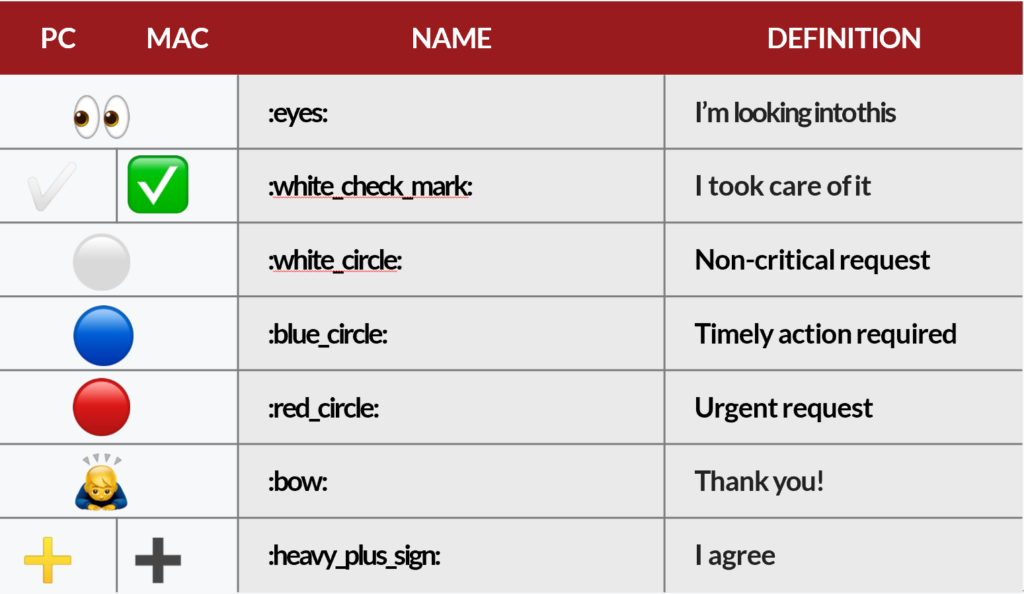
Top Five Tips for Communicating in Slack
Here are some suggestions for managing your day-to-day work and notifications:
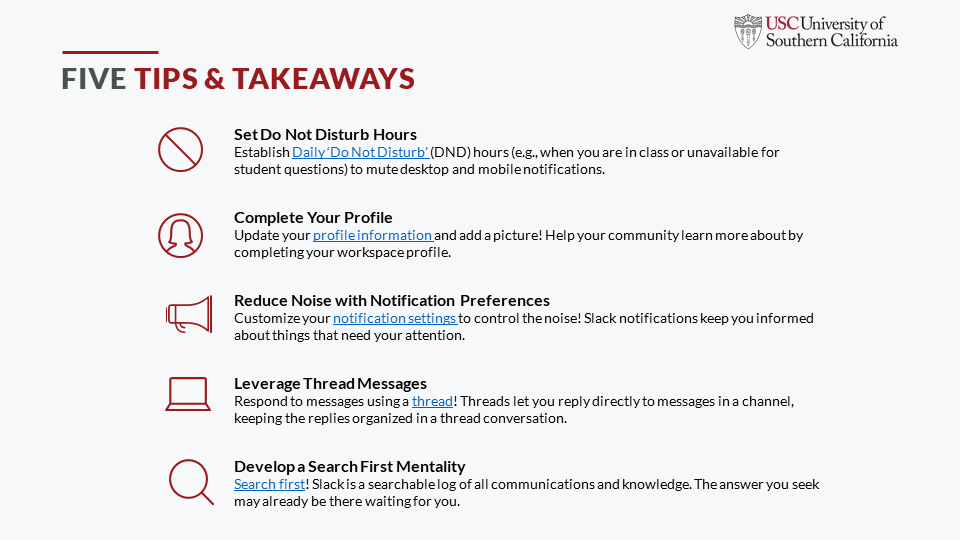
Frequently Asked Questions
Slack is a central collaboration hub for faculty, students, and staff. Faculty can use Slack class channels to enhance the classroom experience and provide a centralized location for students to collaborate with their peers on course content, discuss class material, conduct office hours, and so much more.
Slack is a messaging app for students, faculty and staff. It brings threads of communication and files into one place, where they’re instantly searchable and available wherever you go. Learn More in a demo or check out the USC Keep Teaching website.
The Enterprise Grid is a secure USC Slack organization composed of multiple workspaces and requires Single Sign On.
A workspace is a separate instance of Slack specific for a school that sits under the USC Enterprise Grid. A workspace has its own administrators and permission settings, and its own members, channels, and apps to enable a large group of people to collaborate long term.
A channel is a context-based conversation where groups of people can communicate, and interact with information related to a common topic (e.g., project). These can be public or private, and can be within a single workspace or shared across multiple workspaces (i.e. organization channels like #its-announcements).
Slack is available to active faculty, staff, and students.
No, Slack channels will automatically be set up for classes within the school workspace they sit under before the start of the term if the school has opted in.
Yes! Reach out to the Customer Support Center at 213-740-5555 to receive assistance in setting up a Slack channel for your courses.
No, students will automatically be added to Slack course channels based on the classes they have signed up for the semester.
Yes! You can set up additional channels for your class to fit the needs of your course. Recommended additional channels include office hours, Q&A, and discussion sections.
Yes! All automatically created channels will use the following convention: #term year – course code – section. For additional channels you create to support your classes should also include this nomenclature, plus the purpose of this additional channel.
Please reach out to your local IT support contact. If you do not know your contact, you can find them on the ITS contact list here.
To optimize Slack’s features, download the app onto your desktop and/or mobile devices. Download the Slack app at https://slack.com/download.
Use of Slack is governed by USC’s polices including those found at:
USC Policies – https://policy.usc.edu/
USC Information Security Policies and Standards – https://trojansecure.usc.edu/information-security-policies/
USC Information Security Acceptable Use Policy – https://trojansecure.usc.edu/files/2020/04/P01-acceptable-use-v1.5.pdf
USC Policies Student Issues – https://policy.usc.edu/student/
Quick reference guides, toolkits, and videos for using Slack is available on Keep Teaching! https://keepteaching.usc.edu/
You can find answers to most Slack questions in Slack’s help site at https://slack.com/help
You may update your profile (i.e. name, job description or title, phone number, time zone, etc.) as well as photo in Slack.
All Trojans authenticate through Shibboleth to access Slack.
Yes. Slack is approved to use in accordance with USC’s Health Insurance Portability and Accountability Act (HIPAA) policies. Please note, there are specific requirements related to disclosing protected health information to others. Contact usc-ciso@usc.edu or compliance@usc.edu, if you have questions.
Yes. Slack is approved to use in accordance with USC’s Family Educational Rights and Privacy Act (FERPA) and student privacy policies. Please note, there are specific requirements related to disclosing identifiable student information to others. Contact usc-ciso@usc.edu or compliance@usc.edu, if you have questions.
o General rule: the larger and busier the channel, the more people should be encouraged to use threads to keep conversations organized
o Always use threads to respond to announcement posts in read-only channels
o Always use threads to respond to questions in help/discussion channels
o Strongly encourage students to ask questions in channels so that everyone can learn
o Address instances of poor etiquette; take the opportunity to quickly and empathetically educate
o Make clear when you are available to respond to direct messages and when you are not
Fill out the appropriate Service Request –
Yes. See the “Merging Slack Class Channels” section above, for step-by-step instructions on how to complete this process.
Slack Help Center Resources
Additional Resources
Additional resources, such as user guides and webinars, can be found on Slack and USC’s websites to ensure you have the materials you need to successfully use Slack in the classroom, as outlined below:
- ‘Your Guide to Slack for Higher Education’ Slack Website Post
- ‘Slack 101 for End Users’ Slack Website Guide
- ‘Set Your School Up for Distance Learning with Slack’ Webinar
- ‘Getting Started with Channels’ Webinar
Train the Trainer Resources
Slack Overview Video
Slack Settings
Slack Interface
Authorizing Zoom for Slack
Slack Use Cases
Additional Slack Tips
Click each link to find more information from the Slack Help Center.
- Set your Slack status and availability
- Let your students, peers, and staff know your working hours
- Guide to desktop notifications
- Manage your sidebar preferences
- Format your messages
- Search in Slack
- Find members in the directory
- Share messages in Slack
- Star channels and direct messages
- Upload and Share Files
- Set a reminder
- Slack keyboard shortcuts
